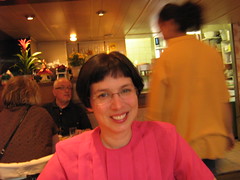Ok, slowly trying to catch up on these interviews… So, Renee is now working on an MA in fiction, and interestingly, she seems to share some of the same interests as Sher in thinking about writing or text as part of artistic practice. Right now she’s finishing her MA project which involves both fiction and non-fiction intertwined and she’s thinking about going on to a PhD in which she can explore narratives in electronic literary forms. Work she’s already done in De Geuzen reflect some of these interests, like the virtual seance with Guy Debord or some aspects of the Female Icons series.
Along with discussing these aesthetic and theoretical aspects, we talked a lot about how she used technology and what really affects women’s use. A couple of really interesting things emerged from this part of the interview. Because Renee has been a tutor at Piet Zwart this year, we were talking about that experience, in particular about women learning to program. Anyone who knows Florian Cramer (the director of the Media design MA program at Piet Zwart) knows of his preference for the command-line and has probably heard his reasoning on why graphical user interfaces are limiting to users. Since I know Renee is not a really avid coder, I asked her what her view on this was and how the students reacted.
(Since coding is almost always part of gender stereotypes around tech, this is a useful way to create an opportunity for gender to arise in the discussion without forcing it into the story artificially.)
Anyway, a couple of things came up. First, all of the students seemed to manage the coding without too much trouble (and the class is about 50/50 women and men). Second, at the same time, the students most likely to get into “tech as toy” thinking were men, but in such a small group, that doesn’t really show anything. Third, and most interesting, she thought the real reason women appeared to have a harder time learning to write code or use the command line has to do with the way their time is structured, especially if they are taking care of kids or other family.
Renee felt, and I can certainly confirm this from my own experience, that learning a programming language or to use the command line takes a kind of sustained attention over time that often women don’t have if they have families. She realized this after reading Martha Rosler’s work on how women read magazines (among other topics). Apparently women read magazines like Vogue because they can put them down and pick them up easily, and being interrupted is not too much of a problem. So her idea is that graphical user interfaces enable a similar ability to put down and pick up computer work. Her own experience has been that if she is trying to (or succeeds at) learning how to code something or do something via the command line, if she then has an interruption of several days (or of course longer) she loses her place and has to start over figuring out how she did it. I have found this as well, and when I later spoke with Erna Kotkamp and Audrey Sampson, they each independently mentioned similar experiences
I don’t think this indicates a difference between how men and women think, rather, anyone would probably have trouble if they were frequently interrupted and I think women are more prone to being interrupted or perhaps allowing themselves to be. Certainly anyone with children experiences this problem, and women are still more likely to be primary caregivers, especially when kids are very young (a time when one is lucky if one can squeeze out an hour of uninterrupted time from caretaking). But further, I suspect that women are less likely to insist on uninterrupted time because it may seem self-centered. –The persistence of this particular aspect of gendered socialization is still surprisingly strong and it showed up in most women’s reluctance to feel using tech for fun was even relevant to our discussion.
So when I ask how or why they use tech, most women only talk about reasons they feel are serious, worthwhile, important, etc. Though some may actually play with it in the same way men do, or use tech in the same way for the same reasons, they seem to perceive or at least describe their use very differently. This raises interesting challenges in how to best interpret my interviews if I want to make any general comment about women and tech/new media in the Netherlands.
I’m sure I’m forgetting some other important ideas–but maybe the ones that stick are most important. Yeah, that’s it… 😉 Well, I’ll check with Renee, but that’s it for now.
